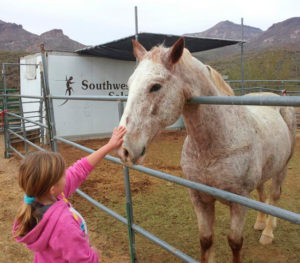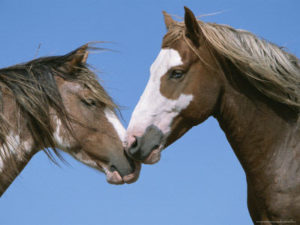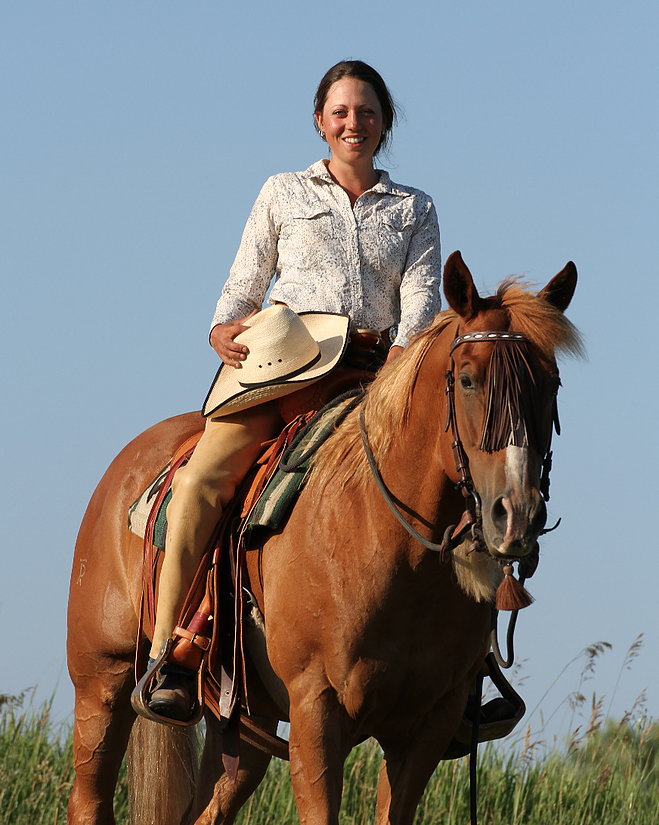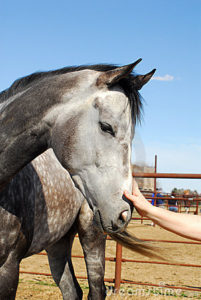Amy Skinner runs Essence Horsemanship and is a frequent guest columnist for our sister site, NickerNews. Read her columns here.
Here, she writes about the need to understand horses’ sensitivity to touch:
People who come to my barn are probably befuddled by my posted sign: “Please do not feed or touch the horses.” While many are familiar with the request, it can seem a bit harsh.
Let me explain:
Some people are extroverted. Some are introverted. Some people like to hug, while to others the thought of being touched by a stranger makes their skin crawl. Anyone requiring a larger “bubble” knows the discomfort of being forcibly snuggled by a well-meaning person without feel for the the recipient’s body language.
People emit feels just the way horses do. They can be: inviting, closed off, accepting, listening, or not. Many people seem to talk without noticing whether the other party is engaged or listening, but a person who is feeling and truly engaging reads the other person’s body language and adjusts accordingly.
When a person approaches a horse just to pet it, they often disregard the horse’s appearance, its telling signs, and its general needs. Many times people go to right up to the horses face and crowd it, or immediately go for its lips and muzzle. This is the equivalent of hugging a person who you’ve just met. It can also encourage a horse to crowd, or lip, or nip in response.
 My Morgan gelding, Geronimo, has a tendency to be pushy and nippy. He often approaches or follows people, crowding them a bit. A well-meaning person may think he wants to be petted. In a short time, they’d find themselves next to a pushy monster with a bay muzzle and lips exploring their skin in a way they probably hadn’t hoped for. Being petted in this way doesn’t make him happier or feel loved, it makes him frustrated and pushy. He is much happier when he receives space and is asked in turn to also give space. When I do pet him, it’s in a way that provides reassurance and helps to calm him.
My Morgan gelding, Geronimo, has a tendency to be pushy and nippy. He often approaches or follows people, crowding them a bit. A well-meaning person may think he wants to be petted. In a short time, they’d find themselves next to a pushy monster with a bay muzzle and lips exploring their skin in a way they probably hadn’t hoped for. Being petted in this way doesn’t make him happier or feel loved, it makes him frustrated and pushy. He is much happier when he receives space and is asked in turn to also give space. When I do pet him, it’s in a way that provides reassurance and helps to calm him.
My fiery chestnut mare, Dee, usually prefers not to be petted. She is not affectionate except in some occasions with some people. To be respectful of her, I pet her when it’s appropriate and usually in a very slow and still way. Sometimes for her a touch on the forehead or neck is just enough.
Every horse’s needs are different and each moment may require a different type of touch.
 As a kid I grew up riding jumpers, and a “pet” for them when they responded correctly was a type of smack on the neck. Sometimes people pet their horses in brisk or hurried ways. But a pet should be reassuring and peaceful in order for it to be beneficial and meaningful.
As a kid I grew up riding jumpers, and a “pet” for them when they responded correctly was a type of smack on the neck. Sometimes people pet their horses in brisk or hurried ways. But a pet should be reassuring and peaceful in order for it to be beneficial and meaningful.
Horses rely on feel to survive, which is why I prefer people don’t pet my horses. Each touch should mean something. If I’m riding my horse and I notice its attention is off somewhere but I need it back on me for a left turn, for example, I could initiate that left turn by a touch on the left side of its neck. Over-petting or rude petting dulls this essential form of communication, making stronger aids necessary.
Most people know to ask before petting a strange dog. The same should go for people and horses – if it isn’t yours, ask, and even if you are given the go ahead, pay attention to the horse and pet in a way that doesn’t encourage rudeness but does encourage peace and relaxation.
It’s not that petting is bad. It’s not that treats are bad. Talking isn’t bad. Affection isn’t bad. But if our words and touch are to be meaningful, then silence and quiet have to be a factor in our conversation as well.


Well said! I have a client that loves to pet and hug her horse on his face. He hates it, and he’s shown that by swinging his head and hurting her. I’m giving her different ways to show her affection which has made him more relaxed and safer to be around.
Great article! I have a Blm mustang that is crystal clear that he doesn’t like his head patted or people too close to his face
I feel like a rodeo clown when we are out… intercepting well meaning people. Nichols isn’t aggressive at all , so when so people get to him he tolerates it. When I ask people to not part his face, I try to redirect them to his shoulder. I find that the experienced horse people are more likely to try to go for his face though….
This is very true of cowboys, too. Especially if they trained that horse from colt. They do not want anybody petting, touching, nor riding their horse. It is a sign of respect to not touch another cowboy’s horse. It is also safe. You never know how a different horse might act or react to an unwanted touch.
However, sometimes, if you ask a cowboy nicely, they will let you pet their horse on the neck, only. No face mashing. Good article!
When folks venture into my sphere to scratch my forehead, I wait until they turn before I bite them on the shoulder. It’s just a little thing I do; makes me ‘quirky ‘!
Any time I hear someone “petting” a horse by smacking it on the neck, I want to do the same to that person. I also don’t like anyone to pet my horse or my dog without my permission, and I always ask if it’s okay to touch anyone else’s animals (on the shoulder). Great article and good job looking out for your horses!
Don’t forget to be polite about it. Most people just don’t know…Remember we all represent the industry.
How do you stop someone in touching or give her treats. I have told the person twice. He still does it when I am at work. He is a renter on my property.
Perhaps suggest that if the horse chokes from a treat or needs any medical attention or new training because of his handling, HE will be responsible for the bills.